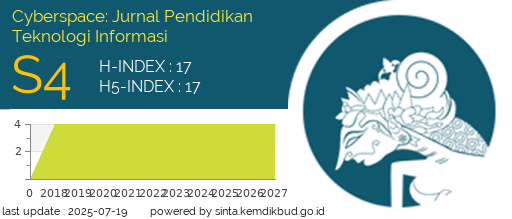Comparative Evaluation of NDVI-Based Vegetation Classification Using Rule-Based Thresholding and Random Forest Models
DOI:
https://doi.org/10.22373/agmq9j89Abstract
This study aims to compare vegetation classification performance using NDVI derived from Sentinel-2A and Landsat 8 satellite imagery through two different approaches: rule-based classification and machine learning with the Random Forest algorithm. The rule-based approach applies a fixed NDVI threshold of 0.45 to distinguish vegetation and non-vegetation areas. In contrast, the Random Forest model was trained using 70% of the labeled data and tested on the remaining 30%, with NDVI values from both satellite sources as input features. The evaluation results show that the Random Forest model achieved perfect classification accuracy (100%). However, this may be due to using the same labeled dataset for both training and validation, which can lead to overfitting. On the other hand, the rule-based classification yielded an accuracy of 79.7%. This lower performance is likely caused by several factors, including the resolution differences between Sentinel-2 and Landsat 8 imagery, and the subjectivity involved in selecting the NDVI threshold value. The manual threshold setting may lead to bias and a higher number of misclassified pixels. Therefore, while rule-based methods are simple and interpretable, they are less robust. Machine learning approaches, such as Random Forest, offer more flexible and accurate classification when supported by properly separated training and validation datasets.
References
[1] Y. F. Wijaya and S. Y. J. Prasetyo, “Model Penilaian Tata Guna Lahan Dengan Citra Landsat 8 OLI Menggunakan Algoritma XGBoost Diwilayah Beresiko Tsunami (Studi Kasus : Kota Palu Sulawesi Tengah),” Indones. J. Comput. Model., vol. 4, no. 1, pp. 23–28, 2021, doi: 10.24246/icm.v4i1.4981.
[2] R. Nuzulia, A. Misbullah, L. Farsiah, Rasudin, Husaini, and S. A. Nazhifah, “Comparative Analysis of XGBoost and Random Forest for Used Car Price Prediction,” Proc. Int. Conf. Electr. Eng. Informatics, pp. 125–129, 2024, doi: 10.1109/ICELTICs62730.2024.10776051.
[3] H. Chen, “Car price prediction based on multiple machine learning models,” in Proc. 2nd Int. Conf. Data Analysis and Machine Learning (DAML), 2024, pp. 92–95, doi: 10.5220/0013509000004619.
[4] Z. Shao, M. N. Ahmad, and A. Javed, “Comparison of Random Forest and XGBoost Classifiers Using Integrated Optical and SAR Features for Mapping Urban Impervious Surface,” Remote Sens., vol. 16, no. 4, 2024, doi: 10.3390/rs16040665.
[5] S. A. Nazhifah and A. Putri, “Teknik Decision Tree dalam Pengklasifikasian Penggunaan Lahan dengan Menggunakan Citra Sentinel-2A MSI,” J. Teknol. Inf., vol. 5, no. 2, pp. 163–168, 2021, doi: 10.36294/jurti.v5i2.2379.
[6] Safira, M. Amiren, S. A. Nazhifah, M. Rusdi, Nizamuddin, and A. Misbullah, “Comparison of Support Vector Machine and Random Forest Methods on Sentinel-2A Imagery for Land Cover Identification in Banda Aceh City Using Google Earth Engine,” Indones. J. Comput. Sci., vol. 13, no. 6, pp. 9121–9133, 2024, doi: 10.33022/ijcs.v13i6.4510.
[7] J. Christopher, “The science of rule-based classifiers,” Proc. 9th Int. Conf. Cloud Comput. Data Sci. Eng. Conflu. 2019, no. January 2019, pp. 299–303, 2019, doi: 10.1109/CONFLUENCE.2019.8776954.
[8] M. Der Yang and H. H. Tseng, “Rule-Based Multi-Task Deep Learning for Highly Efficient Rice Lodging Segmentation,” Remote Sens., vol. 17, no. 9, 2025, doi: 10.3390/rs17091505.
[9] V. Gupta, H. Gaur, S. Vashishtha, U. Das, V. K. Singh, and D. J. Hemanth, “A fuzzy rule-based system with decision tree for breast cancer detection,” IET Image Process., vol. 17, no. 7, pp. 2083–2096, 2023, doi: 10.1049/ipr2.12774.
[10] A. Maier, H. Köstler, M. Heisig, P. Krauss, and S. H. Yang, “Known operator learning and hybrid machine learning in medical imaging - A review of the past, the present, and the future,” Prog. Biomed. Eng., vol. 4, no. 2, 2022, doi: 10.1088/2516-1091/ac5b13.
[11] A. Putri and Hayatun Maghfirah, “The Mapping of Vegetation Density Changes Based on the Normalized Difference Vegetation Index Using Landsat OLI in The Coastal Region of Aceh Barat,” Indones. J. Comput. Sci., vol. 12, no. 6, pp. 3250–3260, 2023, doi: 10.33022/ijcs.v12i6.3489.
[12] N. S. Mansor, H. Awang, C. K. Min, A. Bluszcz, A. Candra, and S. Khamis, “Monitoring land surface temperature on urban expansion using normalised difference vegetation index and Google Earth Engine,” J. Inf. Commun. Technol., vol. 24, no. 3, pp. 22–43, 2025, doi: 10.32890/jict2025.24.3.
[13] S. Barthwal, “Rule Based Land Cover Classification For Hilly Terrain Using Sentinel SAR Images,” pp. 4–8, 2025.
[14] Z. Wang, Z. Li, Y. Xie, C. Souza, J. S. S. Filho, and S. Pinheiro, “AI-based Validation of Deforestation Using High-Resolution Satellite Imagery in the Brazilian Amazon,” Int. Arch. Photogramm. Remote Sens. Spat. Inf. Sci. - ISPRS Arch., vol. 48, no. 3, pp. 583–588, 2024, doi: 10.5194/isprs-archives-XLVIII-3-2024-583-2024.
[15] B. A. H. Sherbo, J. Iacozza, A. O’Hara, S. T. Zhao, M. Ghazal, and C. J. D. Matthews, “Validation of satellite imagery for quantitative population assessment and monitoring of Atlantic walrus,” Remote Sens. Appl. Soc. Environ., vol. 32, no. June, p. 101065, 2023, doi: 10.1016/j.rsase.2023.101065.
[16] C. Kruse, E. Boyda, S. Chen, K. Karra, T. Bou-Nahra, D. Hammer, J. Mathis, T.
Maddalene, J. Jambeck, and F. Laurier., “Satellite monitoring of terrestrial plastic waste,” PLoS One, vol. 18, no. 1 January, pp. 1–20, 2023, doi: 10.1371/journal.pone.0278997.
Downloads
Published
Issue
Section
License
Copyright (c) 2025 Sri Azizah Nazhifah, Maulyanda, Andriani Putri, Usfita Kiftiyani

This work is licensed under a Creative Commons Attribution-ShareAlike 4.0 International License.
Authors who publish with Cyberspace Journal agree to the following terms:
- Authors retain copyright and grant the journal right of first publication with the work simultaneously licensed under a Creative Commons Attribution License that allows others to share the work with an acknowledgement of the work's authorship and initial publication in this journal.
- Authors are able to enter into separate, additional contractual arrangements for the non-exclusive distribution of the journal's published version of the work (e.g., post it to an institutional repository or publish it in a book), with an acknowledgement of its initial publication in this journal.
- Authors are permitted and encouraged to post their work online (e.g., in institutional repositories or on their website) prior to and during the submission process, as it can lead to productive exchanges, as well as earlier and greater citation of published work (See The Effect of Open Access).


















